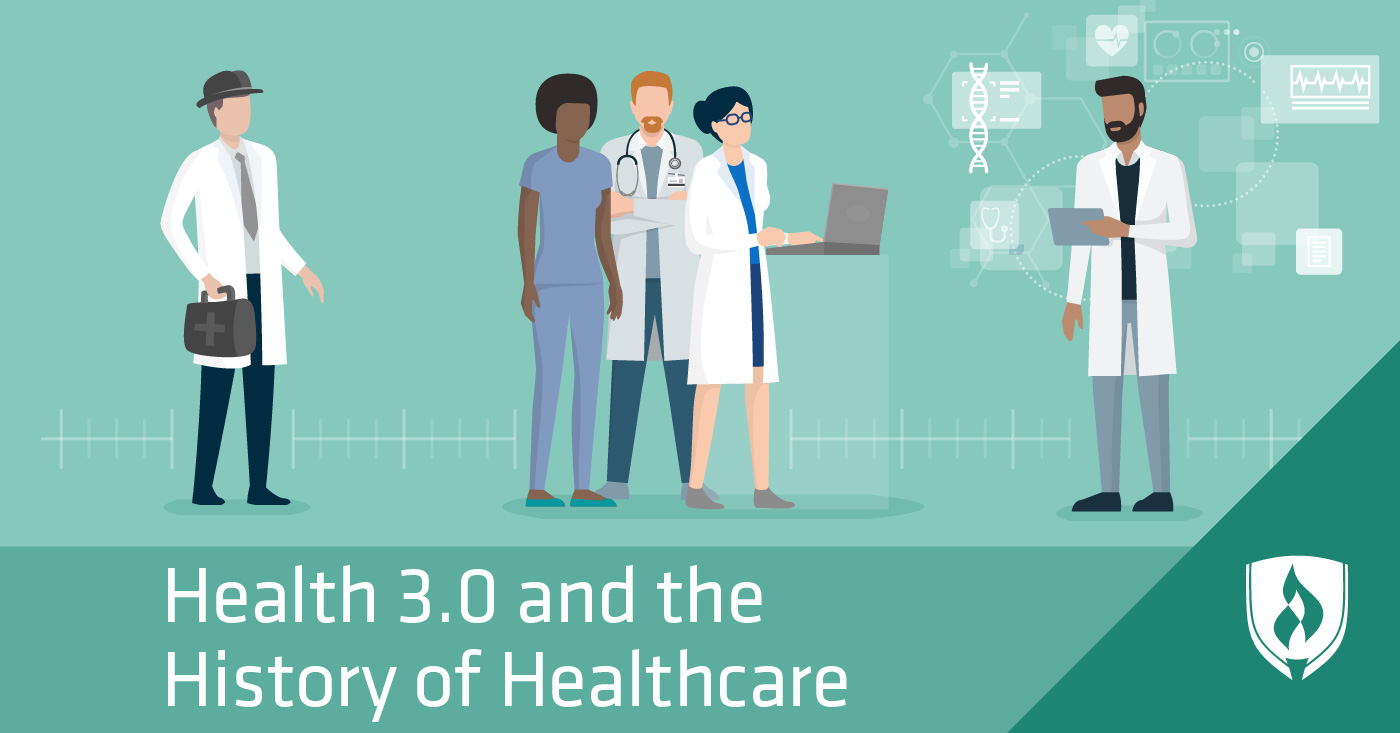
It’s too complicated. It’s always changing. Whether you’ve worked in healthcare or been a patient yourself, you’ve heard this about the system. It’s a labyrinth system that leads a lot of people to declare it broken. Even after coaching your mom through the most complicated knee replacement process you thought possible, you still don’t understand exactly how things work, and you’re not sure anyone else does either.
It’s true. Healthcare in America is a complex and ever-shifting industry that makes a lot of people frustrated. It is also one of the most important, personal and worthy causes in existence. It doesn’t get more life-and-death than this.
If you’ve ever wanted to make healthcare better but felt like it was just too complicated to even begin, this article is for you. We’ll explore where healthcare started in the U.S., how it’s changed, and how you might fit into a better, more sustainable future—what some are calling health 3.0.
The past, present and future of healthcare
One way to think about the U.S. healthcare system’s modern history is to separate it into 3 different phases: 1.0, 2.0, and 3.0.
Physician/patient relationship: Health 1.0
Imagine the healthcare of your grandparents. They and all their siblings went to the same physician in the same town most of their lives. Imagine the white coat in the little room and the butterfly stickers from nurses. Since the beginning of American organized medicine in the early 1900s, this was more or less the picture of healthcare. It revolved around the generalist physician, the same physician who would deliver you as a baby would then deliver your children decades later. There were pros and cons to a system like this.
On one hand, your physician knew you. They knew your medical history, and the relationship between a physician and their patient was key. They counted on it to inform their practice.
On the other hand, the physician held most of the power. Hospital administrators did not hold as much sway over practitioners as they do today. The result was often inconsistency among physicians, underutilized nurses and a rigid, unquestionable hierarchy.
While this era in healthcare is often romanticized by providers today, there is much to learn from both its successes and failures moving forward.
Big medicine: Health 2.0
Around the 1970s, healthcare commodification and provider consolidation began to change medicine in a big way. Many thought that competing in the free market like any other business would drive quality and efficiency in healthcare. While this did lead to innovation—particularly in technology—there have also been unintended consequences from both the free market consolidation of healthcare providers and attempts at reform.
One of the biggest changes during this phase is an Affordable Care Act-era reform calling for all healthcare providers to implement electronic medical records (EMR) systems. This allows for the easier tracking and transfer of health information and helps tackle the lack of physician accountability from the last era of healthcare. With a much more consistent and accessible format for detailing appointments, providers are held to a different standard.
Like with many other well-intentioned healthcare initiatives, electronic health records systems fix some problems while also causing others. A national poll of physicians by Stanford Medicine found that most physicians believe EMR systems take valuable time away from their patients. A reported 62 percent of providers’ time spent on patients are tied to navigating and inputting information into EMR systems instead of engaging face-to-face.1 With an average of 30 minutes per patient, that’s less than 12 minutes to listen, ask questions and build a relationship.1
With such a small window of time, physicians may not be able to get a complete picture of their patients’ symptoms, stressors and other diagnostic factors. This can then cause quite a negative ripple effect—an ineffective assessment and diagnosis can lead to poor outcomes, which lead to additional costly visits, unhappy patients and overworked providers. While that’s taken to the logical extreme, it’s clearly not an ideal state for providers or patients.
While health 2.0 saw much advancement and helped distribute power among healthcare professionals, it’s clear there’s still room for improvement.
The future of healthcare: Health 3.0
There is no singular problem with healthcare just as there is no singular solution. Improvements can be made in a lot of different areas, but for that to happen, providers and policymakers alike need to share the same goals.
In the past, better care for a lower cost has been the battle cry. However, in the coming era many have called for a broader goal, often referred to as the quadruple aim. It includes better outcomes and lower costs but also addresses better patient and provider experiences. It acknowledges that patients who are treated as individuals are more likely to engage in their own health, thereby improving their outcomes. It also acknowledges that providers who are burnt-out cannot provide quality care.
So rather than simply good care at a low cost, the aim is for good care at a low cost from happy providers to happy patients. The crux of it, however, is that every part of the aim must work together. If providers suffer, so will patients and their outcomes, which will ultimately raise costs. If costs go up, patients suffer, which affects their outcomes, which affects providers and so on. To succeed in this goal, its aims must be inseparable.
That leaves the question of how. How will we reach these goals? What must change?
That’s where you come in. In order for change to come, healthcare needs motivated administrators who care about supporting providers and patients. It needs people who care about things like creating better-crafted financial incentives, updating EMRs and reducing the physician-to-patient ratio. While medical staff are the beating heart of care, administrators are the structure that make it all possible.
Fixing healthcare is not about reinventing the wheel. The tools for curating a healthy population already exist. It may seem like healthcare is too complicated or corrupt to change, but people are speaking out. Like anything so big, change is slow and starts small, but it’s there. The only question is—will you be a part of it?
Never too complicated to care
While addressing the systemic issues in our healthcare system will certainly take more than one person on a mission, you still have the opportunity to manage positive change on smaller scale. By earning your Master of Healthcare Administration (MHA) degree, you can gain the skills and insight you need to really make an impact—collaborating with providers, support staff and patients to create a more personal, proactive system. You could help establish the future of healthcare.
For more information about a program, check out the Rasmussen College Master of Healthcare Administration degree program to learn how you can position yourself to make a difference.
1Stanford Medicine, National Physician Poll: How Doctors Feel About Electronic Health Records, [accessed February, 2020] https://med.stanford.edu/content/dam/sm/ehr/documents/EHR-Poll-Presentation.pdf




